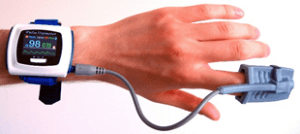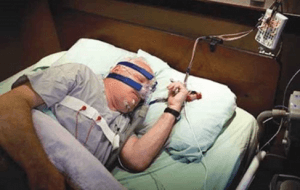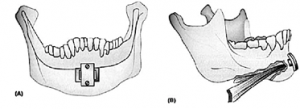It’s a medical disorder. It is characterized by frequent pauses of breathing during sleep.
Breathing stops repeatedly. It can happen dozens to hundreds of times each night. Each time ,the person stops breathing for 10 seconds or more ,then gasps suddenly for air or wakes up feeling breathless. Between each gasp or awakening and the next time breathing stops the person may snore loudly.
Why should I learn about Sleep Apnoea?

Because Sleep Apnoea is a serious health hazard. It can affect quality of life negatively by impaired alertness and altering mood and memory.
Being tired can affect every part of life . For example it can cause:
- Motor vehicle crashes
- Injuries
- Personality changes
- Poor concentration
- Irritability
Sleep Apnoea may be linked to other serious health problems:
- High Blood pressure
- Heart rhythm abnormalities
- Stroke
- Type 2 Diabetes Mellitus
- Depression
- Obesity
- Glaucoma
- Chronic fatigue
Treatment can make a world of difference:
Millions , who took Sleep Apnoea Treatment early say that they’re living stress free , energetic and fuller lives.
- It reduces Daytime sleepiness and increases daytime energy and stamina
- Prevents or delays the progression of Type 2 Diabetes
- Lowers Blood Pressure & Diabetic Complications
- Relieves excess stress on the heart thus reducing the potential risk for Heart Attack, Stroke and Heart Disease
- Treated patients enjoy better health and get more out of life.
Types of Sleep Apnoea
There are three types of Sleep Apnoea:
OBSTRUCTIVE SLEEP APNOEA (OSA);
Everyone’s muscles relax during sleep. This narrows the airway, but in people with OSA the airway narrows so much that it closes. As the airway is blocked , air supply to the lungs is threatened or stopped altogether resulting in reduced blood oxygen level. Because of this an OSA sufferer often wakes up when asleep but is not aware of the same.
This is the most common type of Sleep Apnoea.
CENTRAL SLEEP APNOEA (CSA)
In Central Sleep Apnoea ,the airway stays open but the brain stops telling the muscles that control breathing to work. CSA is characterized by airflow cessation due to reduced neural output from the Central Nervous System.
This is the rarest type of Sleep Apnoea.
MIXED SLEEP APNOEA:
This type involves both a blocked airway and a brain signal problem. For example a person may have periods of sleep apnoea mixed with periods of obstructive sleep apnoea.
TOP TEN SYMPTOMS OF SLEEP APNOEA
- Loud irregular snoring , snorts ,gasps and other unusual breathing sounds during sleep
- Long pause in breathing during sleep
- Excessive daytime sleepiness
- Fatigue
- Obesity
- Changes in alertness, memory
- Changes in mood , personality and behavior
- Impotence
- Morning headaches
- Frequent trips to bathroom at night
ANYONE CAN HAVE SLEEP APNOEA
But it’s more common among:
- Males
- People who are overweight- 50% of OSA occurs in obese/overweight patients & men in particular
- People who have a family history of sleep apnoea
Even if you aren’t in any of these categories , you can have sleep apnoea.
DIAGNOSING SLEEP APNOEA
This may involve several steps:
A SLEEP AND HEALTH HISTORY:
Questions may be asked about :
- Your snoring pattern
- How you feel during the day
- Your general health
- Any medications you may be using
A PHYSICAL EXAMINATION:
This may include checking for features that can cause a narrow airway. This may involve examination of :
- Mouth
- Throat
- Neck
LAB TESTS :
Blood tests can rule out other health conditions.
SLEEP STUDIES ;
There are different kind of studies and one may need more than one. These include:
OXIMETRY

A simple sleeve is placed over one of the fingers. It’s attached to a machine that records certain measurements while you sleep incuding your :
- Blood oxygen level
- Pulse rate
- Blood pressure
POLYSOMNOGRAPHY

A technician tapes or glues sensors to your body. While you sleep the equipment recordsbody functions including your :
- Brain waves
- Eye movements
- Breathing
- Heartbeat
- Muscle activity
- Body’s oxygen level
Sleep studies may be done at a sleep centre or at home using a portable equipment.
HOW IS SLEEP APNOEA TREATED
It depends on the individual condition.
IN MILD CASES
The person may be advised to:
AVOID SLEEPING ON HIS OR HER BACK

Throat tissues are most likely to sag and block the airway in this position.
LOSE WEIGHT

In some cases throat tissues are enlarged because of too much fat, or they collapse because of pressure from a heavy neck. Losing weight can make a big difference.
STOP SMOKING

Smoking can swell throat tissues. This can add to throat blockage.
AVOID DRUGS THAT CAUSE DROWSINESS

These include alcohol and tranquilisers. They can cause people with sleep apnoea to stop breathing more often or for longer periods of time.
SLEEP APNOEA TREATMENT IN MODERATE TO SEVERE CASES
Using a Continuous Positive Airway Pressure (CPAP) device often helps . The person uses it while sleeping. CPAP is the gold standard treatment for OSA.
CPAP holds the upper airway open during sleep by providing pressurized air via a nasal or full face mask. Effective CPAP therapy has been shown to improve patient’s quality of life reduce the health risks associated with OSA and save on healthcare related costs.
CPAP therapy significantly reduces the cardiovascular (CV) outcomes associated with OSA.
CPAP devices:
USE A SMALL MASK

It fits over the person’s nose ( or in some cases the nose or mouth) . A small bedside pump pushes a steady stream of air through the mask. This air pressure keeps the person’s airway open.
CPAP CAN BE VERY EFFECTIVE
When properly used CPAP is one of the most effective treatments for Obstructive and Mixed sleep apneas.It can also help in some cases of Central sleep apnoea.
For many people having restful sleep is well worth the minor discomforts of using CPAP.
One may need to have a sleep study with a CPAP device to find the proper air pressure.
OTHER TREATMENTS FOR SLEEP APNOEA INCLUDE:
ORAL APPLIANCES

These are also called dental appliances. They look like mouth guards and are worn while sleeping. They can help keep the airway open by:
- Lifting up the soft palate( the soft part of the roof of the mouth near the throat)
- Holding the tongue forward
- Holding the jaw forward
SURGERY

Surgery can be done to remove parts of the soft palate, tonsils or other throat tissues. This widens the airway.
Surgery may also be used to correct problems with jaw position.
For those with Central apnoea ,surgery may be required to correct an underlying condition.
MEDICATION
 Medicationmay be effective only in certain cases. For example, it may help if the sleep apnoea involves a problem with the thyroid gland ( which controls the body’s use of energy and other functions)
Medicationmay be effective only in certain cases. For example, it may help if the sleep apnoea involves a problem with the thyroid gland ( which controls the body’s use of energy and other functions)
KEEP FOLLOW UP APPOINTMENTS
Your doctor may want to:
- Repeat sleep studies or other diagnostic steps to see if your condition has improved
- Adjusting your treatment plan if necessary.
DISCUSS YOUR SYMPTOMS REGULARLY:
Let your doctor know whether your symptoms have gone away, become less severe or changed in any other way.
REPORT ANY PROBLEMS
Let your doctor know if you have any:
- Trouble using prescribed devices
- Side effects
FREQUENTLY ASKED QUESTIONS
Do all people who snore have sleep apnoea?
No. Although many people with sleep apnoea snore, most snorers do not have sleep apnoea. Other causes of snoring may be ruled out.
Will getting rid of snoring stop sleep apnoea?
Not necessarily. For example, there are medical procedures and over the counter devices that can reduce snoring. These may not help with sleep apnoea.
Can sleeping pills help stop sleep apnoea?
No., they can make it worse. Any drug that makes you drowsy can weaken your breathing reflexes or make throat tissues sag even more.
Can children have sleep apnoea?
Yes. Signs may include snoring, restless sleep and behavior problems.
Can sleep apnoea affect babies ?
It’s common for babies to stop breathing briefly. This can be normal.
But be sure to get medical attention if any of the following is true:
- Breathing stops for longer than 20 seconds
- The skin turns pale or blue
- The body is limp
Scientists are studying whether there is a link between sleep apnoea and a sudden infant death syndrome (SIDS)
What can loved ones of people with sleep apnoea do?
A lot for example:
- Never blame the person fpr snoring
- Encourage the person to get medical attention. Go with the person and give your observations about his or her sleep.
- Support the person in staying with his or her treatment plan.

